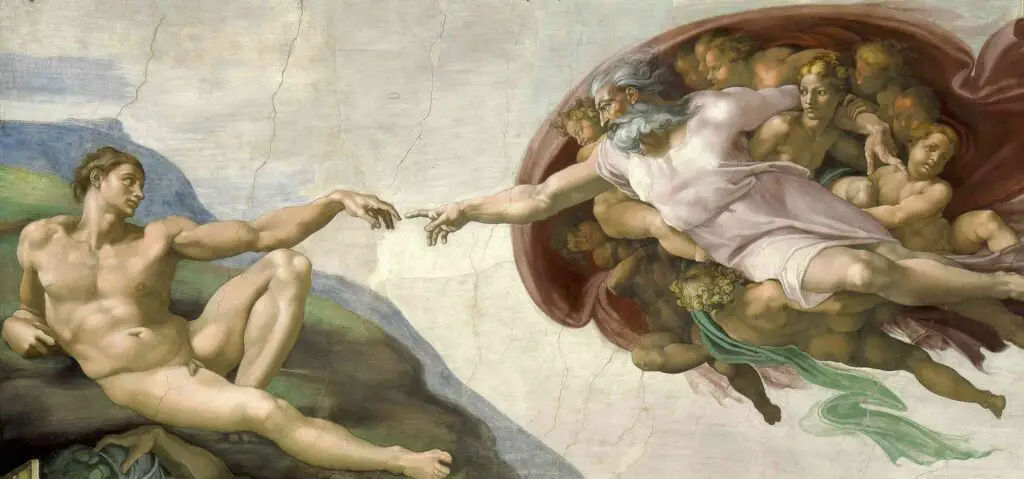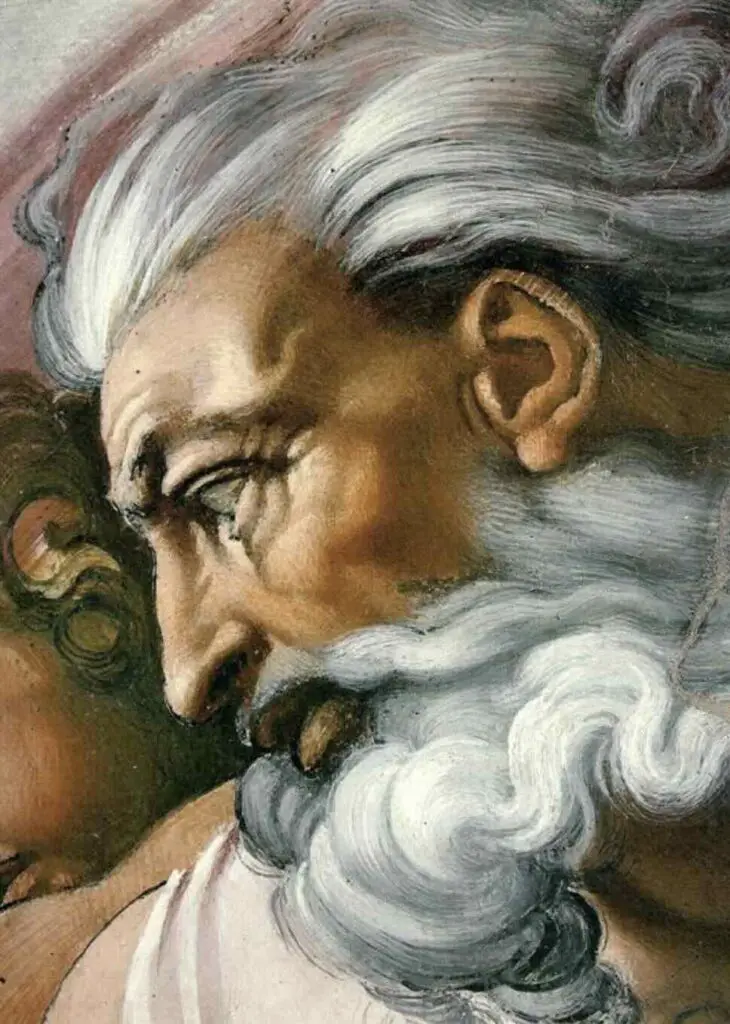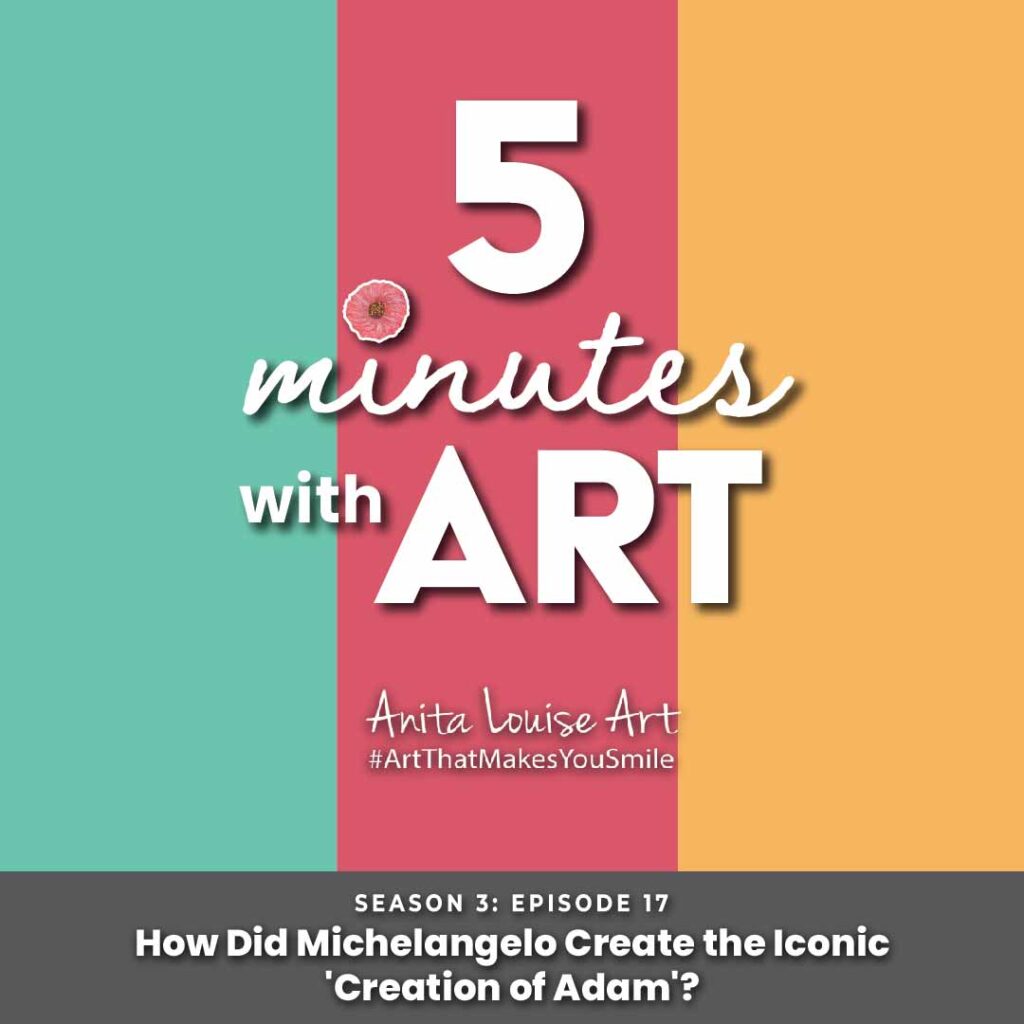Michelangelo’s work on the Sistine Chapel ceiling is a monumental achievement in art history, embodying a blend of artistic mastery and profound spiritual significance. This narrative aims to shed light on the intricacies of his technique, the physical and creative challenges he overcame, and the lasting impact of his work on both art and viewers alike.
By examining Michelangelo’s approach and the subsequent restoration efforts, we gain insight into the enduring legacy of one of humanity’s most remarkable artistic endeavors.
Table of Contents
- The Sistine Chapel Ceiling
- The Creation of Adam Close-Up
- Michelangelo’s Artistic Influence
- Related Questions
The Sistine Chapel Ceiling
Michelangelo was not initially thrilled when Pope Julius II commissioned him in 1508 to paint the Vatican’s Sistine Chapel ceiling. Known more for his sculptures, like the Statue of David, Michelangelo faced the monumental task of fresco painting, which was unfamiliar. This challenge did not deter him; instead, it set the stage for one of the most significant achievements in art history.
One of the first hurdles was the physical demand of the project. Michelangelo painted the ceiling while lying on his back on scaffolding high above the chapel floor, a feat that took four arduous years to complete, from 1508 to 1512. The discomfort and perseverance during this process are well-documented, emphasizing the artist’s dedication and the physical toll taken on him.

Michelangelo’s technique also marked a departure from traditional fresco painting. He applied bright colors on a moist plaster to speed up the drying process, allowing for more vibrant imagery that has survived centuries. His approach to composition was revolutionary; he broke free from the constraints of traditional storytelling in art.
By blending over 300 figures into intricate scenes from the Book of Genesis, including the iconic “The Creation of Adam,” where God breathes life into Adam, Michelangelo introduced dynamism and motion into fresco painting that had never been seen before.
Moreover, Michelangelo employed a technique known as “sotto in su,” which translates to “from below upwards.” This method created an illusion of depth and perspective when viewed from the chapel floor, showcasing his mastery over the interplay of light, shadow, and form. Each scene on the chapel ceiling appears three-dimensional despite the flat surface, a testament to Michelangelo’s innovative approach and understanding of human anatomy and movement.
The inclusion of prophets and sibyls – pagan fortune tellers who, according to Renaissance belief, foresaw the coming of Christ – alongside biblical scenes reflected a blend of Christian doctrine with Renaissance humanism. This alignment with contemporary intellectual trends made the Sistine Chapel ceiling resonate deeply with audiences then and now, making it a monumental work that bridged two worlds.
The post-completion impact of Michelangelo’s work was immense, shifting paradigms in art and significantly influencing the course of Western art history. Artists from Raphael to modern painters have studied the ceiling’s complex compositions, dynamic figures, and innovative techniques. The Sistine Chapel ceiling not only showcases Michelangelo’s unparalleled skill and creativity but also embodies the spirit of the Renaissance—a rebirth of interest in the classical past infused with the humanist thought of the time.
What truly sets the Sistine Chapel ceiling apart is its combination of unparalleled artistic mastery and deep spiritual significance. Michelangelo transformed a daunting commission into a masterwork that continues to captivate and inspire awe in millions of visitors annually. Through overcoming creative and physical challenges, employing innovative techniques, and capturing the human imagination, Michelangelo ensured that the ceiling of the Sistine Chapel would remain an iconic symbol of human achievement.

The Creation of Adam Close-Up
Exploring The Creation of Adam further, the allure largely stems from its powerful depiction of the biblical moment between God and Adam, presenting a sublime interpretation of divine creation. Michelangelo’s skillful execution brings an intense humanism to the forefront, diverging from previous artistic norms by infusing the scene with emotion and energy rather than adhering strictly to religious didacticism. This dynamic portrayal contributes significantly to the fresco’s captivating nature.
The intimacy of the near-touch between God and Adam’s fingers becomes a focal point, symbolizing not only the moment of life’s inception but also the transfer of knowledge and, perhaps, the spark of divinity within humanity. This singular moment encapsulates a complex interchange of power, humility, and connection—themes that deeply resonate with viewers across the ages.
Moreover, the composition surrounding this central action is equally compelling. The figures of God and Adam are enveloped in contrasting spaces—God in a swirling cloak surrounded by angels, suggesting movement and power, and Adam in a languid pose on the earth, emphasizing his connection to the material world. This juxtaposition highlights the dichotomy between the divine and human realms, inviting viewers to ponder their existence and origins.
Michelangelo’s choice of physical portrayal for both characters further enhances the fresco’s allure. God is depicted with robust energy, a whirlwind of divine force animating His approach to Adam. Conversely, Adam is the epitome of Renaissance beauty—his perfect form illustrates the ideal human, yet with an inherent vulnerability in his posture and gaze, making the moment of creation more poignant.
The background and less prominent elements also hold layers of symbolism. The ambiguous form behind God has been interpreted by many as a representation of the human brain, suggesting Michelangelo’s interest in anatomy and possibly indicating a deeper message about the divine spark of intellect. Other figures and details in the periphery contribute to the narrative complexity, inviting viewers to explore the image’s depth beyond the central act.
The color palette and use of light further draw the viewer into the scene. The vivid hues accentuate the figures, setting them apart from the softer background and guiding the eye to the narrative’s core. The strategic use of lighting enhances the three-dimensionality of the forms and serves as a symbolic illumination—divine enlightenment reaching Adam through his interaction with God.
Finally, the theological and philosophical interpretations of The Creation of Adam add layers to its mystique. Scholars and theologians have extensively analyzed the fresco, uncovering varied meanings ranging from the Neoplatonic ideals of beauty and perfection to interpretations grounded in Christian doctrine. These multiple layers of meaning ensure that the artwork remains subject to interpretation and discussion, further securing its captivation for scholars and laypeople.
In sum, The Creation of Adam endures as a masterpiece for its technical brilliance and its ability to communicate profound themes of creation, connection, and the human condition through artistic expression. This convergence of aesthetic, emotional, and intellectual elements makes Michelangelo’s work timeless, continuing to fascinate and inspire generations of viewers.

Michelangelo’s Artistic Influence
Michelangelo’s artistry, particularly his works in the Sistine Chapel, laid a foundation for the dynamism and emotional intensity that became the bedrock of Baroque art. This transition, from the restrained harmony of the Renaissance to the emotive expressiveness of the Baroque period, can trace its roots back to the influential figures and dramatic scenes Michelangelo captured on the chapel’s ceiling.
His figures, endowed with Herculean musculature, signify more than an advanced understanding of human anatomy. They heralded a new era in which the body wasn’t merely observed for its physicality but charged with conveying intense psychological states and divine energy. Artists like Bernini and Caravaggio, pivotal figures of the Baroque period, followed this lead by infusing their works with comparable vigor and emotional depth.

Furthermore, Michelangelo broke new ground in portraying characters with complex emotions. The figures adorning the Sistine Chapel are not just physically robust; they’re fraught with inner struggle and sublime beauty, a testament to Michelangelo’s visionary approach. This multidimensionality encouraged artists to explore more nuanced depictions of the human condition in their work.
Another aspect of Michelangelo’s influence is evident in his ingenuity with spatial composition. His dynamic arrangements encouraged future artists to experiment boldly with figures and spaces, leading to more inventive and engaging visual narratives. This innovation is especially prominent in later Renaissance and Baroque ceilings, where artists sought to emulate the dramatic tension and narrative depth Michelangelo mastered.
Michelangelo’s work also served as a bridge between artistic eras, marrying the High Renaissance’s precise detail and balance with the Baroque spirit’s emerging dynamism. His legacy, encapsulated in the frescoes of the Sistine Chapel, became a touchstone for delineating powerful scenes that blend physical beauty with emotional intensity.
Moreover, his ability to imbue life into the frescos, making scenes leap off the ceiling, inspired subsequent generations to imbue their canvases with similar vivacity. The lifelike quality of Michelangelo’s creations pushed artists to explore realism further, laying the groundwork for the hyperrealistic techniques in later art movements.

Incorporating theatrical milieu and striking contrasts in his work, Michelangelo invited artists to take braver, more theatrical approaches in their expressions. This inclination towards theatricality is a hallmark of the Baroque era, marked by its grandeur and drama, directly reflecting Michelangelo’s pioneering use of dramatic emphasis.
Lastly, Michelangelo’s spiritual resonance, filled with depth and devoutness, paved the way for artists to delve deeper into religious themes with renewed vigor and perspective. The synthesis of divine theme execution and raw human emotion in his pieces has inspired art that simultaneously captures the ephemeral and the eternal.
In essence, Michelangelo’s influence is immeasurable—his work resonates through centuries, molding the trajectory of art history and setting a standard of excellence that continues to fuel artistic ambition and creativity today.
In conclusion, Michelangelo’s Sistine Chapel ceiling transcends mere artistic achievement to become a symbol of human potential and creativity. Through overcoming significant challenges and employing innovative techniques, Michelangelo crafted a masterpiece and set a precedent for future generations.
The ceiling’s profound impact on art and its viewers underscores the timeless nature of Michelangelo’s work, inviting continued admiration and study. Ultimately, the Sistine Chapel ceiling remains an iconic testament to the enduring spirit of the Renaissance and the unbounded possibilities of human achievement.
Listen To Our Podcast About How Did Michelangelo Create the Iconic ‘Creation of Adam’?
Below or By clicking here.

Anita Louise Art is dedicated to art education, great artists, and inspiring others to find and create their art. We love art that uplifts and inspires. #ArtToMakeYouSmile! #ArtToMakeYouHappy!
If you are interested to see any of my art, you can find out more by clicking here. If you are interested in what inspires me and my paintings, you can discover more by clicking here.
We have a free newsletter and would love you to be part of our community; you can subscribe to the newsletter by clicking here. If you have any questions, I would be happy to talk to you at any time. You can reach me, Anita, by clicking here.
Subscribe to our Anita Louise Art YouTube Channel filled with great videos and information by clicking here.
Join us for our podcast “5 Minutes With Art.” Spend just 5 minutes a week with us to discover and learn about great art and artists. You can find out more about our podcast by clicking here.
Related Questions
Did Michelangelo And Leonardo Know Each Other?
Michelangelo and Leonardo da Vinci knew each other but were considered bitter rivals. Leonardo da Vinci and Michelangelo knew each other, but they did like each other. They were both asked to do a commission on the Council Hall of the Palazzo Vecchio and were supposed to work side-by-side; the project was never completed.
By clicking here, you can learn more by reading Did Michelangelo And Leonardo Know Each Other?.
Michelangelo’s Method To Paint The Sistine Chapel Ceiling
He built a large scaffolding structure that could move around the chapel to paint the ceiling; the painting of the Sistine Chapel was an extremely strenuous work that was a huge personal cost both physically and mentally to Michelangelo.
By clicking here, you can learn more by reading Michelangelo’s Method To Paint The Sistine Chapel Ceiling.
Michelangelo’s Sistine Chapel And His Payment
Michelangelo was paid 3200 gold ducats for his work on the ceiling of the Sistine Chapel, which would have been a very lucrative commission. We know that he stopped work on the ceiling for a while due to his not being paid by the Vatican. Michelangelo liked to give the impression that he was a very poor artist, but records have shown that he died an extremely wealthy man.
By clicking here, you can learn more by reading Michelangelo’s Sistine Chapel And His Payment.


